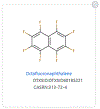Assembly and Curation of Lists of Per- and Polyfluoroalkyl Substances (PFAS) to Support Environmental Science Research
- PMID: 35936994
- PMCID: PMC9350880
- DOI: 10.3389/fenvs.2022.850019
Assembly and Curation of Lists of Per- and Polyfluoroalkyl Substances (PFAS) to Support Environmental Science Research
Abstract
Per- and polyfluoroalkyl substances (PFAS) are a class of man-made chemicals of global concern for many health and regulatory agencies due to their widespread use and persistence in the environment (in soil, air, and water), bioaccumulation, and toxicity. This concern has catalyzed a need to aggregate data to support research efforts that can, in turn, inform regulatory and statutory actions. An ongoing challenge regarding PFAS has been the shifting definition of what qualifies a substance to be a member of the PFAS class. There is no single definition for a PFAS, but various attempts have been made to utilize substructural definitions that either encompass broad working scopes or satisfy narrower regulatory guidelines. Depending on the size and specificity of PFAS substructural filters applied to the U.S. Environmental Protection Agency (EPA) DSSTox database, currently exceeding 900,000 unique substances, PFAS substructure-defined space can span hundreds to tens of thousands of compounds. This manuscript reports on the curation of PFAS chemicals and assembly of lists that have been made publicly available to the community via the EPA's CompTox Chemicals Dashboard. Creation of these PFAS lists required the harvesting of data from EPA and online databases, peer-reviewed publications, and regulatory documents. These data have been extracted and manually curated, annotated with structures, and made available to the community in the form of lists defined by structure filters, as well as lists comprising non-structurable PFAS, such as polymers and complex mixtures. These lists, along with their associated linkages to predicted and measured data, are fueling PFAS research efforts within the EPA and are serving as a valuable resource to the international scientific community.
Keywords: cheminformatics; computational toxicology; environmental chemistry; pfas (perfluorinated alkylated substances); web-based information.
Conflict of interest statement
Conflict of Interest: The authors declare that the research was conducted in the absence of any commercial or financial relationships that could be construed as a potential conflict of interest.
Figures










References
-
- ACD/Labs (2021). ‘ACD/Labs Nomenclature Software’. Available at: https://www.acdlabs.com/products/draw_nom/nom/name/ (Accessed 12 15, 2021).
-
- ChemSpider (2021). Available at: http://www.chemspider.com/.
-
- Dashboard_Downloads (2021). ‘CompTox Chemicals Dashboard: Downloads Page’. Available at: https://comptox.epa.gov/dashboard/downloads (Accessed 12 15, 2021).
-
- Dashboard_Lists (2021). ‘Comptox Chemicals Dashboard List of Lists of Chemicals’. Available at: https://comptox.epa.gov/dashboard/chemical-lists (Accessed 12 15, 2021).
Grants and funding
LinkOut - more resources
Full Text Sources
Research Materials
